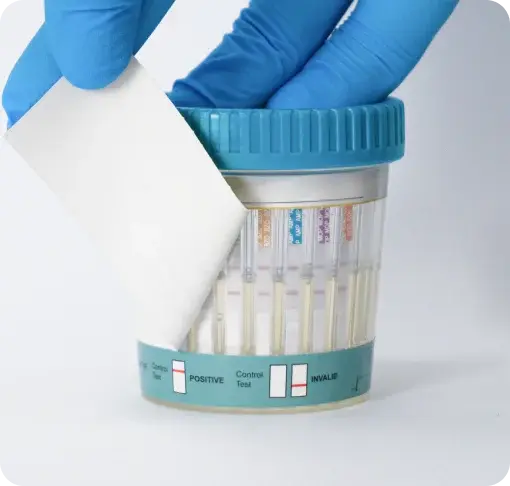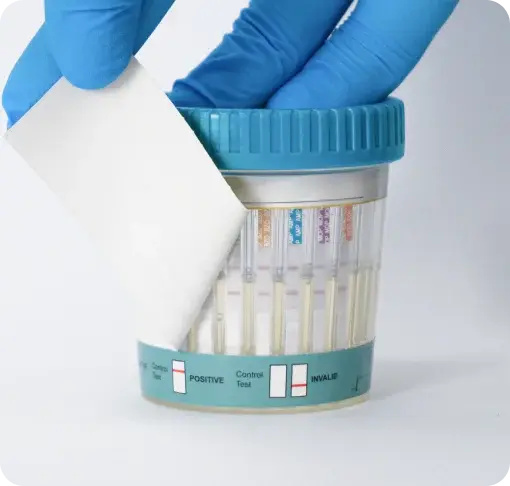Why Choose Oral Fluid Testing for Drug Screening
Oral fluid drug testing (or salvia drug testing) is growing in popularity due to its quick, non-invasive collection process and its ability to detect recent drug use. It is particularly valuable in workplace drug screening, mental health facilities, and community outreach settings across the UK.
Unlike urine testing, oral fluid testing offers two major advantages: faster detection of recent drug use (as highlighted in our case study) and a reduced risk of sample tampering. Since the sample collection is supervised and doesn’t require privacy, there’s no opportunity for the person being tested to alter or substitute the sample. If you’re wondering, “How do I conduct a saliva drug test?” This blog is for you.
What is Oral Fluid Testing?
Oral fluid drug screens detect drugs and their metabolites in a donor’s saliva. Although the terms oral fluid testing and saliva drug testing are sometimes used interchangeably, oral fluid is the preferred scientific term. This is because oral fluid refers to a mixture of saliva and other substances from the mouth, including gingival crevicular fluid, which can more accurately reflect drug levels related to recent use. The term also aligns with industry standards and legal guidelines, ensuring clarity, precision, and consistency across regulated testing environments.
This method is now widely used in the UK for workplace testing, community outreach programs, and healthcare environments. Saliva tests are suitable for detecting substances such as:
-
Cannabis: 1-2 days
-
Cocaine: 1-3 days
-
Opiates: 1-3 days
-
Amphetamines: 1-2 days
-
Methamphetamines: 1-3 days
-
Ect
Many organisations are adopting drug and alcohol saliva test kits because of their reliability and ease of use.
How Does an Oral Fluid Drug Screen Work?
A swab is placed inside the donor's mouth to absorb saliva. The sample is then tested on-site using a portable device, such as a drug screen cube. Results are typically ready in 3–10 minutes, making the oral fluid test drug screen cube ideal for quick decisions and immediate action.
Collection Best Practices
To ensure accurate results and avoid issues like false positive saliva drug tests, follow these guidelines:
-
Nil by mouth for 10 minutes before collection
-
Insert swab between cheek, tongue, and gums to ensure saturation
-
Use room-temperature devices
-
Avoid interference from mouthwash, food particles, or smoking
Real-World Success Story
A mental health facility in the UK switched from urine drug testing to oral fluid testing after repeated negative results despite evident cannabis use—i.e. the workers at the facility could actually smell cannabis on the people being tested. The shorter detection window of saliva testing helped identify recent drug use that was missed by urine screens. This switch significantly improved intervention timing and care planning.
FAQs on Oral Fluid Drug Testing
Q: How soon after drug use can oral fluid tests detect substances?
Most drugs are detectable within minutes, making oral fluid drug screens ideal for on-the-spot testing.
Q: How long do drugs stay detectable in oral fluid?
This varies by substance. For example, how long do drugs stay in saliva depends on the drug—cannabis can be detected for up to 24 hours, while others may only be present for a few hours.
Q: Can mouthwash affect results?
Yes. Mouthwash can dilute the saliva or interfere with detection. Ensure no food, drink, smoking, or mouthwash 10 minutes prior to testing.
Q: Is oral fluid testing reliable for alcohol?
Some oral fluid testing kits are able to screen for the presence of alcohol. It is generally advised to test for the presence of alcohol with a calibrated breathalyser, especially for legal or compliance scenarios.
Q: Is oral fluid drug testing invasive?
No. Oral fluid drug testing is non-invasive and easy to administer. Instead of using a traditional swab, the individual typically allows saliva to collect directly into the device, making the process simple and convenient for both the tester and the person being tested.
Why Choose Oral Fluid Drug Testing?
Saliva drug testing UK trends show growing adoption in safety-sensitive industries due to convenience, accuracy, and reduced tampering. Saliva drug testing kits UK are now widely available, offering real-time screening and detection without the logistical issues of urine testing.
Oral fluid testing provides a non-invasive, cost-effective method of detecting recent drug use—making it ideal for healthcare, social services, and safety-critical environments where quick decision-making is crucial.
Explore our webinars for a full demonstration of oral fluid drug screening best practices, device handling tips, and real-world interpretation guidance. To learn more about our training services, click on the button below.
Read About Our Training


